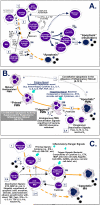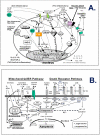PATHOLOGICAL ASPECTS OF THE ANTI-INFLAMMATORY/IMMUNE SUPPRESSIVE RESPONSE IN SEPSIS AND SHOCK
- PMID: 23181245
- PMCID: PMC3505192
PATHOLOGICAL ASPECTS OF THE ANTI-INFLAMMATORY/IMMUNE SUPPRESSIVE RESPONSE IN SEPSIS AND SHOCK
Abstract
Despite the recent advances in contemporary therapeutic, operative as well as supportive care sepsis and its associated co-morbidity/mortality are still a common occurrence in the critically ill trauma/surgical patient. Thus, it remains important to continue to expand our understanding of pathological components which drive the development of immune dysfunction contributing to subsequent multiple organ failure. Here we overview some of the immuno-pathological processes, cells and mediators which may play a role in the development of this immune dysfunctional condition.
Figures


Similar articles
-
Contribution of anti-inflammatory/immune suppressive processes to the pathology of sepsis.Front Biosci. 2006 Jan 1;11:272-99. doi: 10.2741/1797. Front Biosci. 2006. PMID: 16146731 Review.
-
Pathological aspects of apoptosis in severe sepsis and shock?Int J Biochem Cell Biol. 2003 Jan;35(1):7-15. doi: 10.1016/s1357-2725(02)00099-7. Int J Biochem Cell Biol. 2003. PMID: 12467642 Review.
-
American College of Chest Physicians/Society of Critical Care Medicine Consensus Conference definitions of the systemic inflammatory response syndrome and allied disorders in relation to critically injured patients.Crit Care Med. 1997 Nov;25(11):1789-95. doi: 10.1097/00003246-199711000-00014. Crit Care Med. 1997. PMID: 9366759
-
Recent advances in the pathophysiology and molecular basis of sepsis-associated organ dysfunction: Novel therapeutic implications and challenges.Pharmacol Ther. 2017 Sep;177:56-66. doi: 10.1016/j.pharmthera.2017.02.040. Epub 2017 Feb 21. Pharmacol Ther. 2017. PMID: 28232275 Review.
-
Sepsis Care Pathway 2019.Qatar Med J. 2019 Nov 7;2019(2):4. doi: 10.5339/qmj.2019.qccc.4. eCollection 2019. Qatar Med J. 2019. PMID: 31763206 Free PMC article.
References
-
- Longnecker DE. In: Fluid Resuscitation. State of the Science for Testing Combat Casualties and Civilian Injuries. Pope A, French G, Longnecker DE, editors. National Academy Press; Washington,D.C.: 1999. pp. 9–16. - PubMed
-
- Baue AE, Durham R, Faist E. Shock. 1998;10:79–89. - PubMed
-
- Barriere SL, Lowry SF. Crit.Care Med. 1995;23:376–393. - PubMed
-
- Suffredini AF. Crit.Care Med. 1994;22:S12–S18. - PubMed
-
- Natanson C, Esposito CJ, Banks SM. Crit.Care Med. 1998;26:1927–1931. - PubMed
Grants and funding
LinkOut - more resources
Full Text Sources
